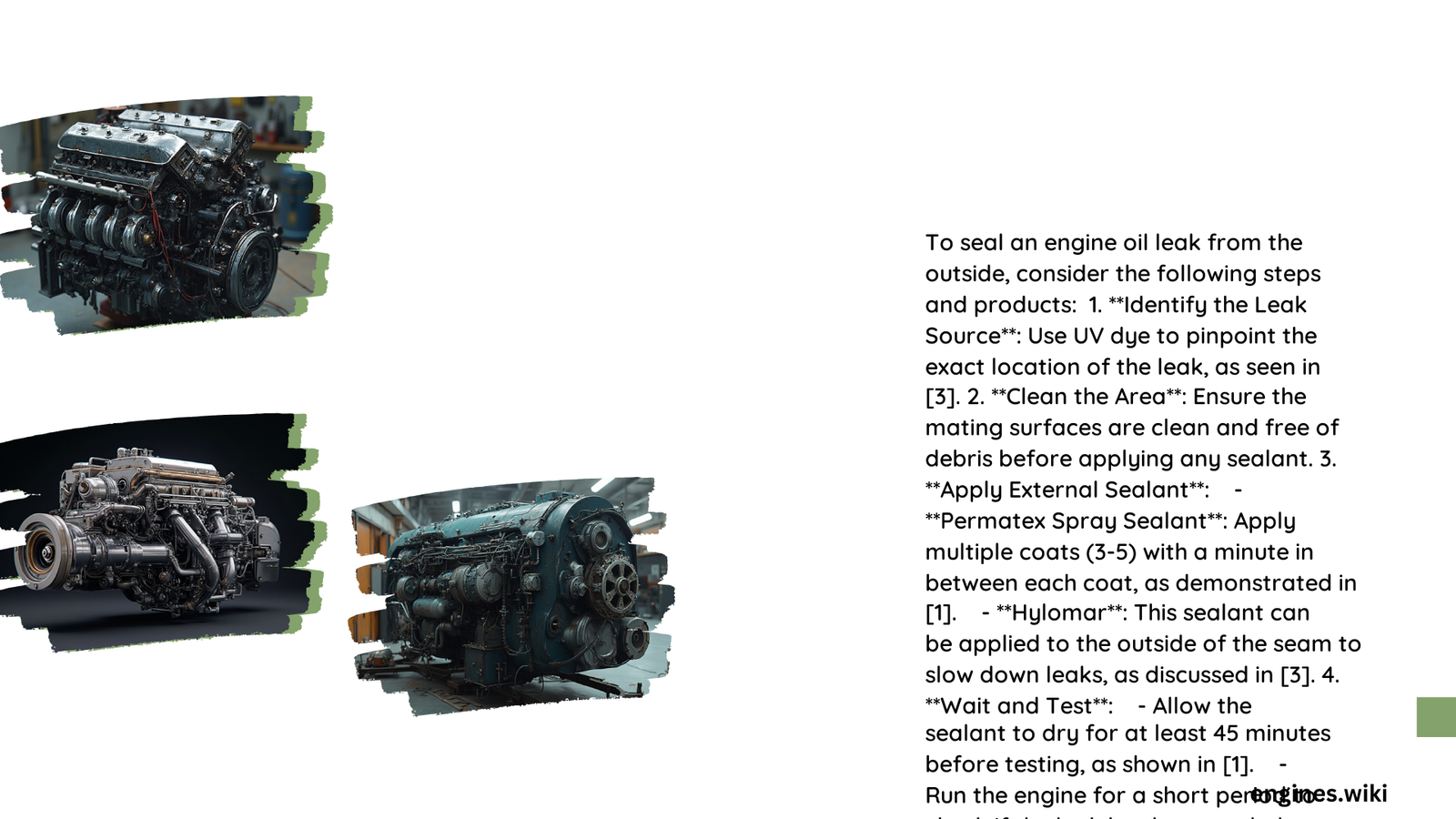Engine oil leaks from external seals can compromise your vehicle’s performance and lead to significant mechanical damage if left unaddressed. A seal engine oil leak from outside manifests through visible oil spots, burning odors, and potential smoke emissions, indicating critical seal degradation that requires immediate professional attention or skilled DIY intervention.\n\n## What Causes External Engine Oil Seal Leaks?\n\n### Why Do Engine Seals Deteriorate?\n\nEngine seals naturally degrade due to several critical factors:\n\n- Temperature Fluctuations: Extreme heat and cold cause seal material expansion and contraction\n- Age and Mileage: Rubber seals become brittle and lose elasticity over time\n- Mechanical Stress: Constant engine vibration and pressure contribute to seal breakdown\n- Poor Maintenance: Infrequent oil changes accelerate seal deterioration\n\n## How to Detect External Oil Leaks?\n\n### Visual Inspection Techniques\n\n| Leak Indicator | Severity Level | Recommended Action |\n|—————|—————-|——————–|\n| Small Oil Spots | Low | Monitor and Schedule Inspection |\n| Consistent Dripping | Medium | Immediate Professional Diagnosis |\n| Large Puddles | High | Urgent Repair Required |\n\n### Diagnostic Methods for Seal Engine Oil Leak from Outside\n\n#### Pressure Testing Approach\n\n1. Prepare Diagnostic Equipment\n – Pressure test kit\n – UV tracer dye\n – Protective gloves\n – Clean rags\n\n2. Conduct Comprehensive Leak Test\n – Introduce UV dye into engine oil system\n – Run engine for 15-20 minutes\n – Use UV light to identify leak locations\n\n## What Are Repair Strategies?\n\n### Cost-Effective Seal Replacement Techniques\n\nRepairing external oil leaks involves strategic approaches:\n\n- DIY Replacement: Suitable for experienced mechanics\n- Professional Service: Recommended for complex seal locations\n- Preventative Maintenance: Regular inspections and timely replacements\n\n### Estimated Repair Costs\n\n- Simple Seal Replacement: $150 – $300\n- Complex Seal Repair: $400 – $800\n- Complete Engine Seal Kit: $500 – $1,200\n\n## What Prevention Strategies Work?\n\n### Maintenance Best Practices\n\n1. Use high-quality engine oil\n2. Perform regular oil changes\n3. Monitor seal condition during routine maintenance\n4. Address minor leaks immediately\n5. Use manufacturer-recommended seal materials\n\n## Technical Considerations\n\n### Seal Material Selection\n\nChoosing appropriate seal materials is crucial:\n\n- Silicone-Based Seals: Excellent heat resistance\n- Rubber Compounds: Cost-effective, standard performance\n- PTFE-Enhanced Seals: Superior durability\n\n## Final Recommendations\n\nAddressing seal engine oil leak from outside requires systematic diagnosis, precise repair techniques, and proactive maintenance. Professional assessment ensures comprehensive resolution and prevents potential long-term engine damage.\n\n### Warning Signs Requiring Immediate Action\n\n- Persistent oil spots underneath vehicle\n- Burning oil smell\n- Visible oil accumulation on engine components\n- Decreased oil levels between changes\n\n### Professional Consultation\n\nIf leak complexity exceeds personal expertise, consult certified automotive technicians specializing in seal replacement and engine diagnostics.\n\nReference:\n- Tires Plus Oil Leak Guide\n- CarAdvise Maintenance Resources\n- Meineke Automotive Services

